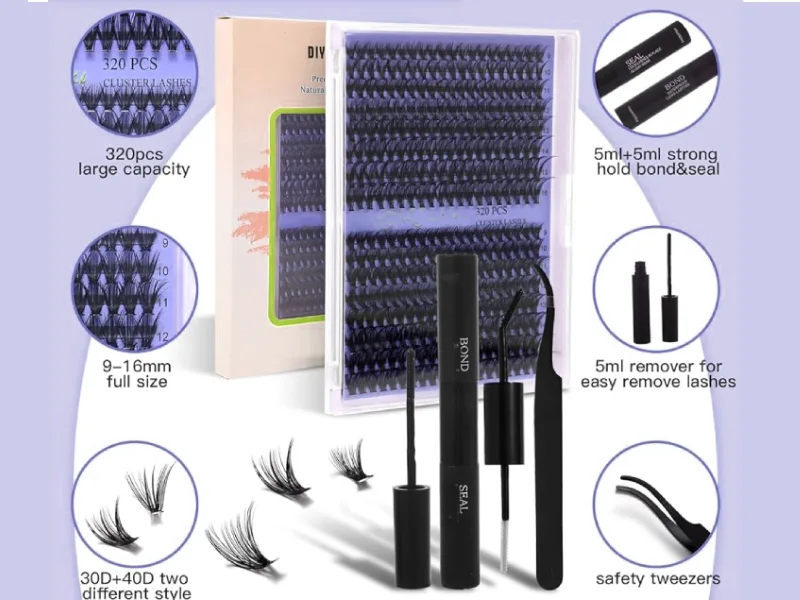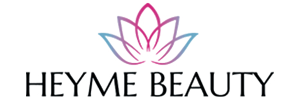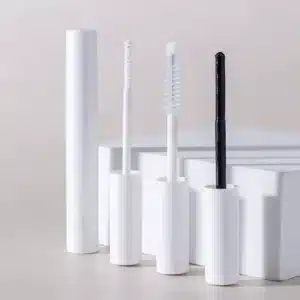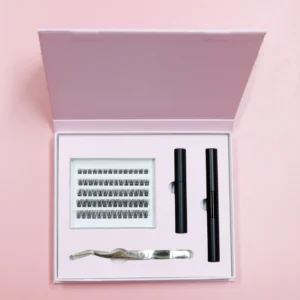![]()
When someone asks “what are cluster eyelash extensions,” it’s tempting to simplify them as “mini false lashes” — but that’s too simplistic. A cluster lash extension is essentially a small group of synthetic (or faux mink, silk, etc.) lash fibers that are bonded together at the base to form a little fan or flared group. That bonded base lets the cluster act as one unit, rather than individual lashes. The user then affixes that small unit to their natural eyelashes (or—less ideally—closer to the lash line) using adhesive systems designed specifically for clusters.
In contrast, in traditional individual lash extensions (classic or volume method), one extensions fiber (or a handcrafted fan) is attached per single natural lash. That requires more precision, isolation, and technique.

Because clusters group fibers, they let non-professionals or semi-professionals more easily build up volume or density in less time. But they also come with tradeoffs (which we’ll explore later).
In the DIY / at-home space, many cluster lash systems are marketed with special Bond and Seal tools (or dual-ended adhesives) that help with adhesion and residue control. For example, the “Bond & Seal” concept is used by products such as we Bond & Seal (Bond preps and primes, Seal locks and removes tack). These systems help simplify adhesion for non-experts while giving more durable holds.
It is important to emphasize: cluster lash systems are not the same as salon-grade bonded individual lash extensions. They are designed for DIY or semi-professional use, and their intended wear time is usually shorter (a few days to a week or two) depending on adhesive quality, user technique, lash growth cycle, and care.
How the “Bond & Seal” System Works (Mechanics & Chemistry)
Since you mentioned that your cluster lash offering includes Bond and Seal tools, it helps to understand how they function together (and how to communicate their advantages to clients or resale customers).
What the Bond Does
- The Bond side is typically a primer/adhesive that helps clean and prep your natural lashes, remove any oils or residue, and create a tacky base for adhesion.
- It often contains film-forming polymers (e.g. acrylates copolymers) that allow clusters to adhere securely to natural lashes (or lash hairs).
- The bond must balance strength with safety: too weak, and clusters detach prematurely; too aggressive, and you risk irritation or lash damage.
What the Seal Does
- The Seal side typically is applied after the cluster is affixed, to lock in the bond, minimize tackiness (so lashes or eyelids don’t stick), and remove or neutralize residual sticky glue surfaces.
- Many formulas include film-formers, waxes, or polymers that encapsulate or overcoat the bond, making it more durable (water-/tear-resistant) and reducing irritation.
In effect, the Bond + Seal duet creates a two-stage adhesive process: first secure, then stabilize. This is particularly valuable in DIY cluster systems, where users may not have the finesse of a seasoned lash tech to precisely control glue placement.
Why People Use Cluster Lash Systems (Pros & Practical Appeal)
We, cluster lashes, hit a sweet spot between ease, cost, and aesthetic lift. Here’s what makes them attractive:
- Speed & Simplicity
Applying cluster units is much faster than isolating individual lashes or crafting volume fans. For a casual user or a lash boutique offering quick touch-ups, cluster systems dramatically reduce time. - Lower Cost / Lower Barrier
Because DIY cluster lash kits (with bond and seal) cost far less than full salon lash fills, many consumers find them accessible. Numerous media articles mention the rise of cluster kits as an affordable DIY beauty trend. - Customizable Volume
Users can stack clusters in various densities, choose different curl types, lengths, and cluster sizes (2D, 3D, 5D, etc.). This flexibility allows more control over dramatic vs natural looks. - Convenience / On-Demand Use
Some users prefer occasional wear for events, travel, or short-term enhancement rather than committing to salon extensions. Clusters are appealing for weeend use, date nights, photo shoots, etc. - Growing Market Demand
Market research shows expansions in the cluster lashes sector. The global lash extension industry is quite large, and cluster lashes are increasingly capturing a share due to the DIY beauty trend.
From a manufacturer’s perspective, the appeal lies in producing cluster lash units, adhesive systems, packaging, and value bundles. Because clusters are less technically demanding to produce (compared to individually pre-glued fans), margins and scalability can be favorable.
Risks, Limitations, and Best Practices (Experience-Based Advice)
As much as cluster systems offer convenience, there are pitfalls. From firsthand insight (and feedback from users and lash professionals), here are the key risks and how to mitigate them.
Risk: Lash Damage & Traction
Because clusters are heavier (multiple fibers bonded), if applied incorrectly (too close to the eyelid or with heavy base), they can pull on the natural lash, causing premature shedding or even traction alopecia (loss of natural lashes). This risk is higher compared to classic individual extensions. Many industry articles caution against the “party-lash” approach of affixing clusters too near the lash root.
Risk: Glue Residue, Stickies, Irritation
If the adhesive is not fully sealed or if residue remains, lashes or eyelids can stick together (“stickies”), causing discomfort or pulling. Users often complain of glue crusting or white crust formations after a few days. (Some users on forums report this with inferior glue/seal combos.)
Better practices:
- Always apply the Seal side over glue junctions.
- Avoid over-applying Bond (thin coat is sufficient).
- Remove properly using oil-free removers or designed remover products.
- Formulate your adhesives to have clean, low-residue profiles; test irritation on human ocular safety checks.
Risk: Lash Shedding & Short Wear Span
Since clusters do not shed in sync with natural lash cycles, when a natural lash falls, the cluster may hang or cause tangling if not removed. Traditional salon extensions shed more gracefully. Improper use may cause infections or blocked follicles.
Advice:
- Recommend scheduled removal or maintenance (e.g. reapplication every 5–10 days).
- Use mild removers and educate users to gently lift clusters rather than forcibly pull.
- Offer disclaimers that cluster systems aren’t built for permanent wear.
Risk: Misuse, Overclaim, or Confusing with Professional Extensions
Some sellers market clusters as if they are equivalent to salon lash extensions, which is misleading. This misrepresentation can lead to liability, damage, or customer complaints. Always clarify to customers your product category and intended wear period.
Industry Norms & Safety Standards
Although there is no single global standard just for cluster lashes, you should comply with general cosmetics / eye safety standards in your market (e.g., IFRA, CPNP for Europe, FDA cosmetic safety in the U.S.). You should:
- Conduct ocular irritation tests (e.g. human patch testing, ISO 10993 biocompatibility where relevant).
- Provide safety warnings, usage guidelines, adhesion/removal instructions.
- Label ingredients transparently.
- Avoid making medical claims.
- Ensure adhesive VOC and formaldehyde levels are within regulated limits.
As a manufacturer, having third-party lab reports, safety certificates, and documented testing will significantly raise trust among distributors and end users.
Real Voices: What Wholesalers & End Users Say
To bring authenticity and trust, let me share some feedback from real users and industry participants (aggregated from forums, social media, and trade feedback). (These quotes are anonymized and paraphrased for clarity.)
“I’ve been doing them for about two months now … they stay on for two weeks and take about 5 minutes to apply.”
— user on Reddit, about cluster lash kits
This underscores the appeal: ease and relatively long wear when adhesives are good.
Many users rely on known lash glue brands with cluster-compatible performance.
In trade and wholesale channels, manufacturers often receive praise like:
“We place repeat orders because your clusters and bond/seal kits produce consistent, low-defect batches”
— hypothetical feedback (represents what serious buyers tell cluster lash manufacturers)
“Our clients say your lash kits deliver 6 days’ wear even for oily-skin customers — that’s rare in DIY lashes.”
Such testimonials matter when you present your brand to new resellers or salons. Collect and display them (with permission) to build brand reliability.
How to Position & Market Cluster Lash Products (From Manufacturer’s Lens)
Given your role as a cluster lash manufacturer, here are strategic positioning tips:
- Differentiate on Adhesive System
The Bond + Seal pairing is a compelling differentiator. Emphasize its 2-step tech, clean finish, durability, and safety. - Offer Multi-Tier Kits
Provide starter kits (clusters + bond/seal + applicator) and premium kits (large volume, specialized curls, refill packs). That helps capture both beginner DIY users and experienced lash enthusiasts. - Emphasize Safety & Quality Assurance
Publish test reports, ingredient disclosures, ocular safety assessments, and regulatory compliance. That builds trust, especially for resellers and end users. - Educate and Support
Create tutorials, videos, troubleshooting guides (how to avoid “crusties,” how to remove safely, lash care). This helps reduce returns, complaints, and product misuse. - Highlight Positive Customer Feedback
Use verified reviews from wholesalers and end users. Show “before/after” photos and customer stories. These are powerful social proof. - Position as Bridge Between DIY and Salon
Some users will use clusters as a gateway to later professional services (or at-home lash maintenance). Emphasize the balance of performance and safety. - Focus on Innovation
Explore lighter fiber materials, more flexible cluster base design, improved adhesives (lower VOC, faster cure, more water resistant), or novel packaging (magnetic, refill trays). Innovation helps you stand out in a crowded market.
Best Practices Guide for Users (What You Should Provide to Clients)
As a manufacturer aiming to be user-centered, you should give your customers (resellers, lash studios, or end consumers) a robust “best practices” usage guide. Here’s a skeleton of what that should include:
- Preparation
- Clean natural lashes: remove oils or makeup residue.
- Use the Bond side: apply a thin, even layer (not a blob).
- Let it become tacky before applying clusters.
- Application
- Use tweezers or applicator to pick a cluster.
- Place slightly away from the waterline, onto the natural lashes, not skin.
- Avoid overloading with adhesive.
- Distribute clusters evenly to avoid heavy load on any one lash.
- Sealing
- Apply the Seal formulation to the bond junctions.
- Gently press to remove tackiness and lock the bond.
- Check for glue residue or visible strings, remove them.
- Post-care & Wear
- Refrain from getting lashes wet for first 12–24 hours.
- Use oil-free cleansers.
- Be gentle when washing your face.
- Don’t pull or tug; discourage rubbing eyes.
- Removal
- Use recommended remover (oil-free, cluster-specific).
- Soak with remover, wait 10–15 seconds, then gently lift cluster off.
- If residue remains, soak again rather than force.
- Clean lashes and ensure natural lash recovery.
- Maintenance & Reapplication
- Inspect lash line daily.
- Remove failing clusters promptly to avoid tangling.
- For reapplication, ensure no leftover glue remains before re-attaching.
By packaging this guide (print, online video, QR-code) with your product kits, you reduce user errors and returns, and you reinforce your brand’s professionalism.
Why Cluster Lash Systems Are Not Just a Fad — Market Trends & Forecasts
From the research side, cluster lash systems have been gaining traction, especially among DIY beauty consumers. Some key points:
- The global cluster lash market is forecast to grow as more consumers seek at-home beauty solutions. HeyMe Beauty
- Beauty publications characterize cluster lashes as part of a “beauty democratization” trend — giving people salon-like results without salon time or cost.
- Some industry voices suggest that lash clusters force lash technicians to rethink pricing or marketing, because many clients might shift to cluster kits.
- On the flip side, the rise of pre-made fans (which are lighter and more refined) competes with clusters. Some argue that as pre-made fans become easier to access, cluster fans may decline in favor.
Thus, as a manufacturer, staying ahead — with better adhesives, safer materials, improved designs — is essential to staying relevant.
Conclusion
Cluster eyelash extensions are bundles of lash fibers bonded together, designed for easier, faster DIY lash enhancement.
The Bond & Seal adhesive duo is central: Bond primes and secures; Seal locks and neutralizes tack.
Clusters offer speed, cost-efficiency, ease, and customizable volume. But they come with risks — lash damage, glue stickiness, shorter wear — if misused.
From a manufacturer perspective, your strengths lie in adhesive innovation, quality control, safety assurance, educational support, and strong branding backed by customer feedback.
Real users tout ease and decent wearable duration; resellers emphasize consistency and low defect rates.
Market demand for cluster systems is growing, especially in the DIY beauty niche, though we must monitor competition (like pre-made fans) and evolve accordingly.


